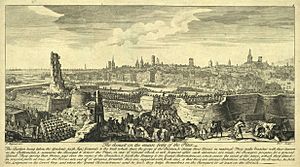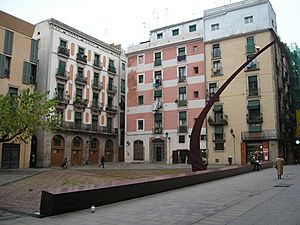Siege of Barcelona (1713–1714) facts for kids
Quick facts for kids Siege of Barcelona |
|||||||
|---|---|---|---|---|---|---|---|
| Part of the War of the Catalans and the War of the Spanish Succession | |||||||
 |
|||||||
|
|||||||
| Belligerents | |||||||
| Commanders and leaders | |||||||
| Strength | |||||||
| 40,000 regulars 80 cannons 20 howitzers |
20,000 regulars of the Army of Catalonia 4,700 militians of the Coronela Some pieces of artillery |
||||||
| Casualties and losses | |||||||
| 10,000 dead or wounded | 13,000 dead or wounded | ||||||
The Siege of Barcelona was a long battle that lasted for thirteen months. It happened at the very end of the War of the Spanish Succession. This war was a big fight over who would become the next king of Spain.
On one side was Philip V of Spain, supported by France. On the other side was Archduke Charles of Austria, who was backed by Great Britain and the Netherlands. They were all fighting for the Spanish crown.
Contents
Why the Siege Happened
After King Charles II of Spain died in 1700 without any children, there was a big question about who would rule next. Philip V was chosen to be the new king. However, a group of powerful countries, including Austria, England, and the Netherlands, supported Archduke Charles instead. This led to the War of the Spanish Succession (1701–1714).
Catalonia Changes Sides
At first, the region of Catalonia accepted Philip V as their king. But Philip V's actions and policies started to make the Catalans unhappy. They felt their laws and freedoms were not being respected. Because of this, Catalonia decided to switch sides and support Archduke Charles.
Barcelona Under Attack
During the early part of the war, Barcelona, the capital city of Catalonia, was captured by Archduke Charles's forces. His ships arrived in the port in August 1705. His troops surrounded the city and captured a fort called Montjuïc. They used this fort to bombard Barcelona until the city surrendered in October. After this, Catalonia and other parts of Spain that were once part of the Crown of Aragon accepted Archduke Charles as their new ruler.
Peace Treaties End the War
After many years of fighting, the major European countries started to make peace. Great Britain and the Netherlands signed a peace agreement with France in 1713, called the Treaty of Utrecht. Austria and the Holy Roman Empire also made peace agreements with France in 1714. These treaties meant that most of Archduke Charles's allies stopped fighting. This left Catalonia and the Kingdom of Mallorca to continue the war on their own.
The Battle for Barcelona
Since most Catalans supported Archduke Charles, the combined forces of France and Philip V (called the Bourbon forces) were not strong enough to capture Barcelona right away. Even after the peace treaties were signed, Catalonia decided to keep fighting. In July 1713, the Catalan parliament (called the Junta de Braços) chose to continue the war. They wanted to protect their special laws and freedoms from Philip V's rule. They also hoped to get help from Britain and Austria, but this help never came.
The City Surrounded
By July 25, 1713, Bourbon forces, led by Duke of Popoli, surrounded Barcelona. However, they didn't have enough cannons to attack the city effectively. So, they waited for more soldiers and equipment.
The Final Assault
In April and May of 1714, about 20,000 more soldiers arrived. The new commander was Duke of Berwick. The attack on Barcelona began again. The Bourbon armies used powerful French cannons to bombard the city. They didn't just target the city's defenses; they also aimed at houses and citizens.
After a failed attempt to enter the city in August, the Bourbon forces finally succeeded on September 11, 1714. The attack started early in the morning. The city walls broke in several places. The main leader of Barcelona's militia, Rafael Casanova, was wounded during the fighting. The battle continued in the streets, led by Antoni de Villarroel, the commander of the Catalan army, who was also wounded.
Finally, the Catalan leaders decided to surrender. Philip V wanted to punish the people of Barcelona harshly. But Duke of Berwick, fearing a longer and bloodier fight, agreed to protect the lives of the people of Barcelona.
What Happened After
The defeat of Catalonia meant the end of its independent government and laws. These were replaced by Castilian laws, making Spain a more centralized kingdom. This event is remembered every year on September 11 as the National Day of Catalonia, also known as Diada Nacional de Catalunya.
The soldiers who defended Barcelona were buried in a cemetery. Today, this place is a square called Fossar de les Moreres. Catalans gather there every September 11 to remember the events of 1714. The old market hall, Mercat del Born, stands over the ruins of a part of Barcelona that was destroyed after the defeat.
See also
 In Spanish: Sitio de Barcelona (1713-1714) para niños
In Spanish: Sitio de Barcelona (1713-1714) para niños


